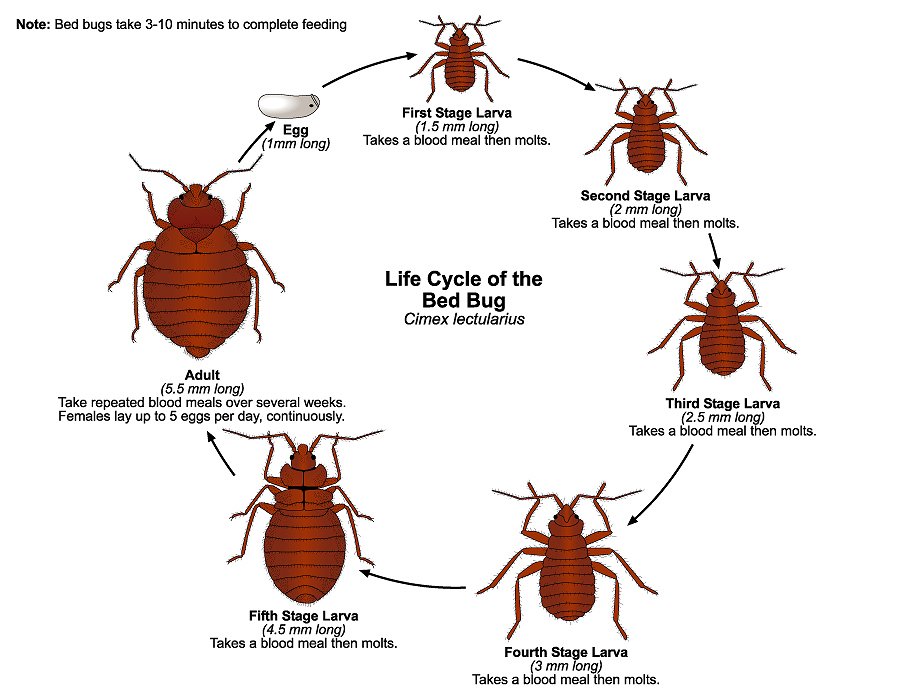

 Wikipedia Sitemap |
|
|  Useful Links 1 Useful Links 2 |


For whatever reason, the power of the media has forgotten all about swine-flu and reinvented an ongoing malady. Bed bugs are nothing new and have been around us humans forever. They deserve lesser attention as the current research has failed to identify them as significant carriers of any human disease.
Bed bugs belong to the Cimicidae family and join mosquitoes and ticks as insects that feed on human blood. They are small but visible to the human eye. They resemble ticks, have wings but crawl, and tend to be white in color, but swell to about half the size of a small pea and turn brown after a meal.
They eat once every few weeks, can survive months between feeds and spend most of their time in hidden seclusion. Growing bugs, called nymphs, feed more often. Their life span is just under a year. I worry more about the mosquitoes in our yards and parks.
Bed bugs are engineered to survive by using a painless method of anesthetic and blood thinning agents to draw out a drop of blood. The process takes a couple of minutes, and they tend to make a double or triple withdrawal just before dawn, under the cover of darkness. The resulting small red marks are hard to diagnose and distinguish from other sources. Some itchiness may be present, but the only concern comes from infection due to the scratching.
Detection is by good detective work. You need to get down on your knees with a flashlight and carefully examine places for them to hide around the bed frame, mattress, and other cracks. You may notice the actual bug, or residual material from eggs or small dark dots of fecal stain on materials.
Because they hide for months, detection is difficult as is eradication. The main concern of late has been the spread of bed bugs. Hotels are increasingly infested, because of the nature of travel and our shrinking planet. You may travel and never see any bed bugs or get bitten by one, but without caution, you will contribute to the spread. These bugs hide in the dark such in an open suitcase on the floor, or in a knapsack in the corner. The controversial toxin DDT served well to control their numbers at one time, before it was banned.
Simple rules apply. I never unpack my bags on my bed. Unpacking outside, washing the contents, and a quick insecticide spray and air out is a good practice. Students are attached to their knap-sacks. They lay them in the most unusual places, never clean them, and store them next to their beds.
Having bed bugs in your home is not a sign of poor hygiene. The term should not be confused with bed mites which are more microscopic, feed on dead skin droppings, universally present, and a common aggravator of allergies.
Here is the simple goal of my column. Make a date with your bed, knapsack or suit-case. Take it apart, scrub it with soap and water, give everything a good vacuuming, buy a new pillow, wash the comforter, and make it a habit to lay nothing but yourself on it, and you can go on to worry about other things!
Related resources:
● Bed Bugs by Melissa Conrad Stöppler, MD, Medical Editor: William C. Shiel Jr., MD, FACP, FACR, from MedicineNet. What are bed bugs? What do bed bugs look like? Where are bed bugs found? What about bed bugs in hotels? How are bed bugs spread? What are the symptoms and signs of bed bug bites? What is the treatment for bed bug bites? How do I detect a bed bug infestation in my home? How do I get rid of bed bugs in the home? What about prevention of bed bug bites?
● Bedbug from Wikipedia, the free encyclopedia.
● Parasites and Health: Bed Bugs from CDC. "The two species of bed bugs (Insecta: Hemiptera: Cimicidae) usually implicated in human infestations are Cimex lectularius and C. hemipterus ... Life Cycle of a Bed Bug (illustrated): Eggs hatch in about 4-12 days into first instar nymphs ... Nymphs and adults take about 5-10 minutes to obtain a full blood meal ... Adults live 6-12 months ..."

● Bed Bug Web Site and Bed Bug Fact Sheet from Department of Medical Entomology, ICPMR, Westmead Hospital, Australia.
● Bed Bug Infestations in an Urban Environment by Stephen W. Hwang, (St. Michael's Hospital, Toronto), Tomislav J. Svoboda (University of Toronto), Iain J. De Jong, Karl J. Kabasele, City of Toronto), and Evie Gogosis (Toronto Public Health, Ontario, Canada).
● Toronto Bed Bug Project. Call Toronto Health Connection at 416-338-7600 if you are concerned about bed bugs. Bed Bug Fact Sheets from Toronto Public Health.
● Bed Bugs from National Geographic. YouTube video, 2:10 min.
● Where do Bed Bugs live and How to Get Rid of Them. YouTube video, 2:13 min.
● New Way to Kill Bed Bugs. YouTube video, 3:14 min.
● How to Get Rid of Bed Bugs from Pest Control Canada. Some Basic Facts, Bed Bug Bites, Symptoms of a Bed Bug Infestation, Disease and Health Risks, Hiding Places, Finding Bed Bugs, Simple Ways to Kill Bed Bugs, Treatment and Control, Prevention.
● DDT Restrictions. In at least 26 countries, DDT is completely banned, and in 12 others it is severely restricted. Total DDT ban: United States 1972, Canada 1985, Chile 1985, Cuba 1970, Liechtenstein 1986, Korea 1986, Poland 1976, Singapore 1984, Switzerland 1986. Soviet production and use continued secretly after the 1970 ban. In some cases, DDT production even increased.